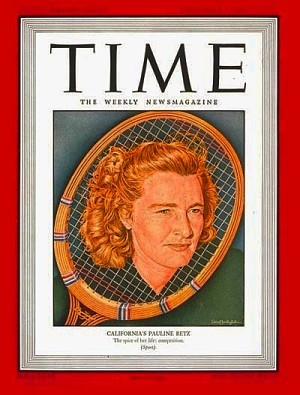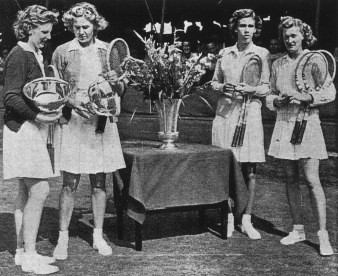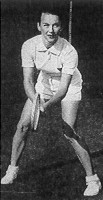|
TIME Magazine, September 2, 1946, p. 57: SPORT: The Way of a Champ... The Perils of Pauline. |
Tennis.com
has feature stories, results, events information, and hundreds of excellent tennis instruction articles and tips. You can search Tennis.com with this form. Be specific--if you simply search for "backhand" you will get countless results.
|
|
Last week they were all in Boston, at suburban Brookline's venerable Longwood Cricket Club, the next-to-last stop on the tournament line. There the National Doubles Championships were as stake. The goal they were all shooting for-- the U.S. Singles-- begins this week at Forest Hills. The big names: 1) skyscraping Yvon Petra of France, Wimbledon winner; 2) solemn Frank Parker, the U.S. champion; 3) brilliant but unpredictable ex-Coast Guardsman Jack Kramer; 4) jugeared Bill Talbert, best of the wartime tournament regulars. Among the women, there was one whose name led all the rest-- California's Pauline Betz. At 27, Pauline, a friendly, attractive and aggressive American girl, is three-time winner of the U.S. Women's Singles. This week she will be out to win a fourth time-- a feat that has been accomplished six times before.* Pauline is a trim 5 ft. 5; her hair is strawberry blonde, sun bleached and wiry. Principally because of her green eyes she seems to have a ready-to-pounce, feline quality. A straightening of her shoulders is a characteristic mannerism-- a squaring away that seems to symbolize, in an otherwise relaxed girl, a won't-be-beat spirit. As a tennis player, Pauline (who prefers to be called Bobbie) is an obvious cut or two below the alltime greats, [Suzanne] Lenglen and Helen Wills Moody. But she has certain natural gifts of champions: she is cool; she is confident of winning; she has a quick eye and a good court sense; her footwork is superb. No matter how impossible a shot looks, she makes a dive at it. Says she: "I am a retriever." On a cement court, which she likes best, her acrobatics are rough on the hands and knees; on a grass court, she grass-stains her starchy white outfit and doesn't mind. After a bad spill at Wimbledon this summer, she bounced back up to wisecrack: "And they say it takes three weeks to get laundry done in England." As a court strategist, she rates alongside another Californian, ex-Champ Helen Jacobs. Say tennis writers sadly: if Pauline only had the strokes. No Foot Stamping. Experts debate whether her brilliant backhand (rated more powerful than Lenglen's but not as consistent) makes her other strokes look weak. Whatever the fact, sheer virtuosity is only relatively important to Pauline Betz. The thing that makes her go is a terrifying determination not to lose at anything-- tennis or checkers, or gin rummy at a cent a point. Competition is the spice of her life. Says Pauline: "If I were a second-rater, I'd quit." The Betz competitive urge is the kind that once kept powerful Molla Bjurstedt Mallory, a sturdy Scandinavian with square-cut bangs, at the head of the class during and after World War I. Neither of them went in for irate foot-stamping like Lenglen, nor walked off the court as Helen Wills Moody did in 1933 when it looked as if she would take a licking. When Pauline's hit-or-miss game misfires, she usually controls herself...
Tennis for the King. The Betz Club got its first foreign seasoning in June. For the first time since 1938, the top five U.S. women players-- Betz, Osborne, Brough, Pat Todd and Florida's Doris Hart-- headed for England to play Britain's top women in Wightman Cup competition. The U.S. team blasted Britain's out-of-practice best off the courts in seven straight matches without dropping a set. Betz won the Wimbledon Singles crown, a glory at least equal to the U.S. championship. In Paris three weeks later, Osborne handed Betz one of her few beatings. The Betz Club romped up to Sweden, and played barelegged before 88-year-old tennis bug King Gustav. Then the other club members returned to the U.S., but Pauline headed for a Swiss resort (Gunten) to celebrate her 27th birthday with millionheiress Barbara Hutton. They swam, jitterbugged and went mountain-climbing for ten days-- Pauline's longest vacation in ten years. Something Ladylike. Pauline Betz has had a tennis racket in her hands almost every day since she was nine. Her mother, a gym teacher at Los Angeles' Jefferson High School, put it there... From the time she was 16, and got her first real tennis instruction (from Bruce Ainley, pro at swank Town House), Pauline set the alarm clock for 5 a.m., took a basketful of balls to the practice court and worked on her strokes until it was time for school. At 21, she won a scholarship to Florida's tennis-conscious Rollins College, played No. 4 on the men's team and got enough As in the classroom to earn a scholarship in economics at Columbia. She didn't like Manhattan's weather, and quit Columbia after six months. At 23 she was national champion. Hobnobbing with Headliners. She liked the life-- checking in & out of hotels, hopping planes, eating in restaurants, hobnobbing with headline names. Winters, when the tournament season is over, she rarely spends and evening in the Betzes' small Los Angeles apartment, where the family serves vegetables in her sterling silver trophies. Usually she is to be found with movie folk, especially the Bill Powells. At the elegant Beverly Hills Tennis Club, she has little trouble beating Cinemactors Paul Lukas and Robert Taylor. Men Are Better. But against top-flight tennists, Pauline, like all women players, is far behind. The 700-year-old French game of tennis, traditionally as much a lady's as a man's game, was introduced to the U.S. in 1874 by a woman, Mary E. Outerbridge. For 62 years women have played championship tennis at Wimbledon, at first in ankle-length gowns and long sleeves, yet no woman has ever done better than to beat the best men in juniors. On the subject of male v. female in tennis, Pauline says: "It's ridiculous to compare them." Her reasons: a man anticipates the play better, runs faster, hits harder, lasts longer. Pauline has had a succession of boy friends, but says with a grin: "I can't find anyone who wants to be married one month out of the year." But she admits a fear of turning 30 without getting married... Egg on Her Face. Last fall, after three years as national champion, Pauline Betz had her first major setback, from 33-year-old Sarah Palfrey Cooke, who came out of retirement to tournament play. Sarah took the crown away from Pauline at Forest Hills. Pauline marched home to California, beaten and burned up-- at herself. She sought out Eleanor Tennant, an old tennis teacher, who coached Champions Bobby Riggs and Alice Marble, once charged the movie's Marion Davies $1,000 a month for lessons. Teacher Tennant decided to buck Pauline up first. Says Eleanor: "When a gal has egg on her face, the first thing to do is let her know she is the world's greatest player." Then came the details. Tennant, a believer in "easy does it" tennis, decided that Pauline's strength was in her killer instinct ("She has the quality of a stevedore"). So she strengthened Pauline's weak forehand by cutting two-thirds off the backswing and adding it to the follow-through. Her service was none too robust, so Eleanor Tennant concentrated on placement. When Pauline took her revamped tennis game on tour this summer, the egg was off her face. Teacher Tennant, who has taught them both, glowingly rated Betz above Alice Marble. Most tennis experts are content to call Pauline the best in a year which has no greats, and wait for the rest of the returns to come in before saying more. 1980's Verdict. Halfway through last week's doubles championships at Brookline, Pauline ran into trouble. Her big toe became infected, swelled up to twice its normal size. In the semi-finals, teamed with Doris Hart, Pauline discarded sneakers, played in heavy woolen socks. They lost. (Osborne and Brough won their fifth doubles championship beating Mary Arnold Prentiss and Pat Todd.) Just how the injury would affect Pauline's playing at Forest Hills this week, no one knew for sure. At Brookline, it interfered with her latest hobby: taking action pictures of her tennis-playing pals, with a new movie camera she bought in Switzerland. At Forest Hills, besides the newsreel cameramen focusing on her, she will have a friend filming her matches with a new camera. Says Pauline: "In 1980 I want to be able to say, 'See what grandma did!'" * Helen Wills Moody won seven times, and Mollja Bjurstedt Mallory eight. |
In the 1946 U.S. National Singles Championships at Forest Hills, Pauline Betz defeated Doris Hart in the Women's Final 11-9, 6-3, and Jack Kramer defeated Tom Brown in the Men's Final 9-7, 6-3, 6-0.
In 1947 Pauline Betz was declared a professional because she was inquiring about the possibility of making a pro tour. She eventually did make two tours of one-night stands, against Sarah Palfrey Cooke in 1947, and Gertrude "Gussie" Moran in 1951.
You can read more about Pauline, Gussie, and their tour with Jack Kramer & Pancho Segura in excerpts from The Game: My 40 Years in Tennis by Jack Kramer.
|
TIME Magazine, August 22, 1946, p. 36: SPORT: Heiresses Apparent The best women tennis players in the U.S. were on view last week in a tournament at the Essex Country Club in Manchester, Mass... the reign of the two current tennis queens, Wimbledon Champion Louise Brough (26) and U.S. Champion Margaret Osborne du Pont (31), seriously threatened for the first time in three years. In last week's semifinals, Brough came up against frail, canny Doris Hart of Jacksonville, Fla., No. 3 in the U.S. rankings. In the damp footing, Brough was unable to play her usual forcing game and Hart beat her with sharp-shooting placements, 6-4, 3-6, 6-1. In the finals, du Pont took Hart's measure, but only after coming from behind, 3-6, 6-4, 6-3.
|
This page's URL is: //sports.quickfound.net/tennis_articles.html



